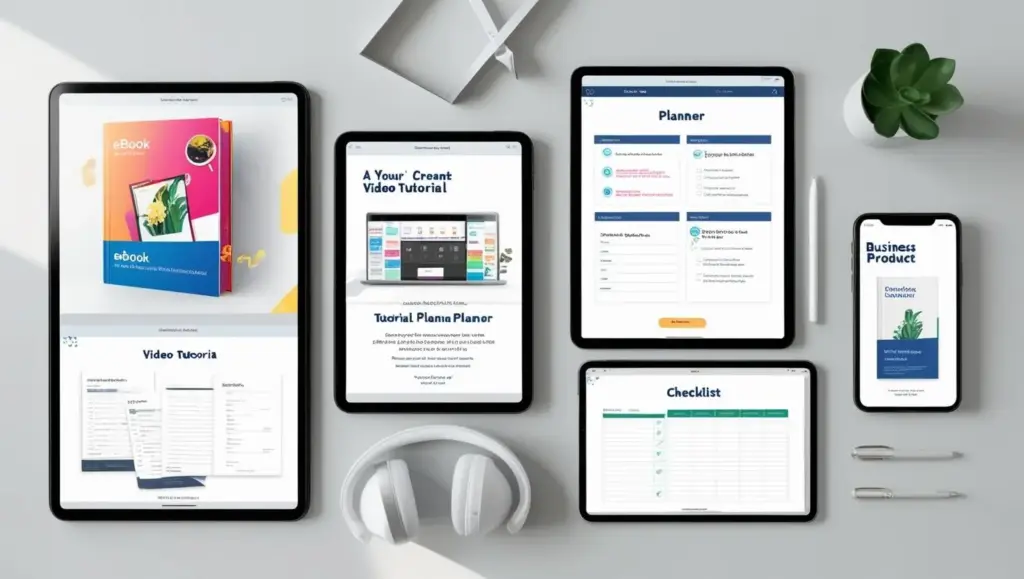7 Digital Products You Can Launch This Month (Even If You’re Starting From Scratch)

Let’s clear something up: you don’t need to be a tech genius, a social media star, or have a huge audience to start making money online and in this article we’ll look at simple digital products you can launch this month, easy-peasy.
Some of the most profitable online businesses are built by regular people who decided to create something once that could sell over and over again—a digital product and whether you’re just dipping your toes into the world of online business or you’ve been circling the idea for a while, digital products are the most beginner-friendly, scalable way to get started. They’re low-cost, high-impact, and once you create one, it can keep working for you 24/7—without extra effort.
In this guide, you’ll discover 7 digital products to sell that are simple, profitable, and totally doable in 30 days or less. I’ll also walk you through tools, examples, and pro tips to help you go from idea to income—fast.
Ready to build your first (or next) digital asset? Let’s dive in.
Why Digital Products Are the Ultimate Online Asset
Before we jump into product ideas, let’s talk about why digital products are such a game-changer for modern entrepreneurs.
💡 1. Low Overhead, High Margin
Unlike physical products, there’s no inventory to buy or store. You don’t need a warehouse, fulfillment center, or even a shipping label. That means your profit margins are sky-high from the start.
🌎 2. Sell Globally 24/7
You can literally make money while you sleep. Once your product is live, it can be sold to anyone, anywhere, at any time.
🔁 3. Scalable Without Limits
Whether 5 people or 5,000 buy your product, your workload stays the same. That’s the beauty of digital scalability.
🧘 4. Perfect for Solopreneurs
If you’re building a brand on your own, digital products let you monetize your knowledge, creativity, or skills without burning out.
🎯 5. Flexible Formats
From templates and guides to audio and video, digital products can match your strengths. You don’t have to force yourself into a model that doesn’t feel aligned.
This is why creators, coaches, consultants, and even side hustlers are leaning into digital—because it works.

7 Digital Products You Can Launch This Month
Let’s break down seven powerful product ideas you can actually start building this week. Each one is beginner-friendly, budget-conscious, and totally customizable to your niche.
1. 📘 eBooks and Guides
Why it works: People are hungry for clear, step-by-step information—and they’re willing to pay for it when it’s well packaged.
If you’ve ever written a blog post, newsletter, or Instagram carousel that taught someone something… you’ve already got the bones of an eBook.
Great for:
- Coaches who want to teach frameworks or habits
- Bloggers with deep-dive how-to content
- Creators with niche knowledge (e.g., holistic health, productivity, social media tips)
Examples:
- “From Burnout to Balance: A 7-Day Guide to Reclaiming Your Time”
- “How to Land Clients on LinkedIn in 30 Days”
- “The Beginner’s Blueprint to Etsy Sales”
Tools to use:
- Google Docs (for writing)
- Canva (for design)
- Beacon (for lead magnets or styled PDFs)
Pro Tip: Don’t overcomplicate. A 15- to 30-page PDF that solves one problem in a clear way can be more valuable than a 200-page book full of fluff. Repurpose your high quality content into a polished e-book, see how you can go about creating engaging blog content here.
2. 🎥 Mini-Courses or Masterclasses
Why it works: Video adds a layer of trust and transformation. People love being taught by a real person—it’s more engaging than text alone.
The best part? You don’t need to be on camera if that’s not your thing. Slides + voiceover is totally fine (and sometimes preferred).
Great for:
- Teachers, coaches, creatives
- Anyone who can break down a topic into a 3–5 step process
- Solopreneurs who want to start building authority
Examples:
- “Launch Your First Instagram Funnel in 5 Days”
- “Confidence on Camera: Masterclass for New Coaches”
- “AI Tools for Creators: A Beginner’s Bootcamp”
Tools to use:
- Loom (recording)
- Podia, Teachable, or Gumroad (delivery)
- Canva (slide decks)
Pro Tip: Keep it simple. A mini-course can be just 3–5 short videos (10–15 minutes each) + 1 worksheet. Don’t let perfection stall your progress.
3. 📋 Printables and Planners
Why it works: Printables are quick wins for buyers. They’re functional, visually appealing, and often under $15—making them an easy “yes.”
Great for:
- Productivity experts, wellness brands, educators
- Lifestyle bloggers or moms with an eye for organization
- Creatives who love design
Examples:
- Daily gratitude journals
- Weekly meal planners
- 30-day self-care challenges
- Business finance trackers
Tools to use:
- Canva (design)
- Etsy or Gumroad (selling)
- Notion (for digital versions)
Pro Tip: Validate with a freebie first. Offer a free downloadable planner page, see if it resonates, then expand it into a full paid bundle.
4. 📊 Templates
Why it works: Everyone wants to save time. Templates give buyers a plug-and-play solution for tasks they’d otherwise struggle with or avoid.
Great for:
- Designers, marketers, copywriters
- Content creators and social media managers
- Freelancers looking to productize their services
Examples:
- Instagram carousel templates
- Email welcome sequence templates
- Proposal decks for virtual assistants
- Canva resumes or pitch decks
Tools to use:
- Canva
- Notion
- Google Docs
- Tella (if you want to walk through how to use the template)
Pro Tip: Group your templates into “kits” or “systems” and price them accordingly. A single template might sell for $9, but a bundle could go for $47+.
5. 🎧 Audio Products or Meditations
Why it works: Audio is intimate, portable, and easy to consume. Whether it’s mindset, relaxation, or motivation—listeners love to plug in and feel transformed.
Great for:
- Mindset and wellness coaches
- Personal development brands
- Creators who are more verbal than visual
Examples:
- Morning affirmations
- Guided meditations for clarity
- Pep talks for productivity or launch prep
- Audio training on goal setting
Tools to use:
- GarageBand or Audacity (recording)
- Gumroad or Ko-fi (delivery)
- SoundCloud or Anchor (if you want to host samples)
Pro Tip: Include a printable or mini guide with your audio product for bonus value—and upsell potential.
6. 🛠 Toolkits and Resource Libraries
Why it works: People will gladly pay for a well-curated set of tools, checklists, and swipe files—especially if it saves them hours of Googling.
Great for:
- Coaches, consultants, business strategists
- Freelancers wanting to share their process
- Educators and productivity geeks
Examples:
- “Launch Toolkit” with planning sheets, swipe copy, and tech stack guides
- “Client Onboarding Library” for service providers
- “Social Content Vault” with 100+ caption ideas and templates
Tools to use:
- Notion or Google Drive (for hosting)
- MemberVault or Gumroad (for access control)
Pro Tip: Keep it updated and market it as a “living library.” Offer lifetime access with updates to increase perceived value.
7. 🎯 Paid Email Series or Challenges
Why it works: It’s simple, automated, and high-converting. Email challenges create a sense of momentum and accountability that free content often lacks.
Great for:
- Personal development coaches
- Creators who want to build community while selling
- Educators and transformation-focused brands
Examples:
- “7-Day Confidence Reset Challenge”
- “5 Emails to Your First Lead Magnet”
- “30-Day Writing Habit Builder”
Tools to use:
- ConvertKit or MailerLite
- Substack (if you’re already publishing there)
- Notion (for prewriting or planning)
Pro Tip: Add a paid upsell (e.g., a group call, workbook, or bonus module) at the end of the series to turn readers into clients.
Tools to Launch Your First Digital Product
Don’t get stuck in tech paralysis. Here’s a basic tool stack you can start with—most of it’s free or budget-friendly:
✍️ Creation & Design:
- Canva – for templates, planners, eBooks
- Loom – record screen or talking-head videos
- Google Docs/Sheets – for writing and sharing resources
💾 Delivery:
- Gumroad – easy storefront and digital delivery
- Podia – great for mini-courses or bundles
- Payhip – another beginner-friendly storefront
- StanStore – a beginner-friendly course / digital product delivery option
💻 Pages & Email:
- ConvertKit – for lead magnets and paid emails
- Carrd – beautiful one-page sites
- MailerLite – great automation at low cost
Start simple. As your income grows, you can always invest in more advanced tools.

Beginner Launch Tips (That Actually Work)
Launching your first digital product doesn’t have to be complicated. In fact, simple launches often outperform complex ones—especially for beginners.
Here are 6 realistic tips to help you go from “I have an idea” to “I made my first sale!”
1. Start with a Single Promise
Don’t try to solve everything at once. Instead, ask:
What’s one specific outcome my product helps someone achieve?
Examples:
- “Feel more organized in 7 days” (planner)
- “Write your first blog post” (template)
- “Learn how to meditate in 3 minutes a day” (audio)
This makes your product clear, compelling, and easier to sell.
2. Test the Waters Before You Build
Before spending hours creating your product, validate the idea with your audience (ask your email list what they’d love to learn):
- Run a poll on Instagram stories
- Ask your email list what they’d love to learn
- Share a teaser post like “Would you be interested in a 5-day [X] toolkit?”
Even a few “yes please!” messages means you’re onto something.
3. Create a “Founding Member” Offer
This is a brilliant beginner strategy. Launch a beta version of your product at a lower price in exchange for feedback. Benefits:
- You get early testimonials
- Your audience feels included in your journey
- You build real momentum
Even 3–5 founding member sales will give you the confidence to keep going.
4. Set a Mini Launch Window
Open cart → Close cart. That’s it. A simple 3–5 day window creates a reason for people to take action.
You can say:
- “Early bird price ends Friday!”
- “Only available for 72 hours before the full version launches”
Deadlines motivate. Even if your audience is small, this works.
5. Make Buying Easy
Don’t lose sales to clunky tech. Make it one-click simple:
- Use Gumroad or Payhip for instant access
- Use Stripe or PayPal to accept payment
- Link directly from Instagram, email, or a simple landing page (Carrd is perfect)
Keep it smooth = more sales, fewer headaches.
6. Celebrate Every Win
Your first sale is a big deal—shout it out! Share your progress, behind-the-scenes, and gratitude on socials. This builds trust and excitement for your brand.
Momentum matters more than perfection. Just getting your first product out there is a massive win.
Want a deeper launch guide?
We’re working on a full post: “How to Launch a Digital Product (When You’ve Never Sold Anything Before)”—coming soon on the blog!
Conclusion
Digital products are more than passive income streams—they’re tools of empowerment. With the right idea, a bit of hustle, and the willingness to test and iterate, you can build a digital product that brings in income, impact, and freedom.
So, here’s your next step: pick one product from this list and commit to creating it. You don’t need to have everything figured out—you just need to start.
👉 Which idea are you launching first?
Share it in the comments and let’s celebrate your first step!